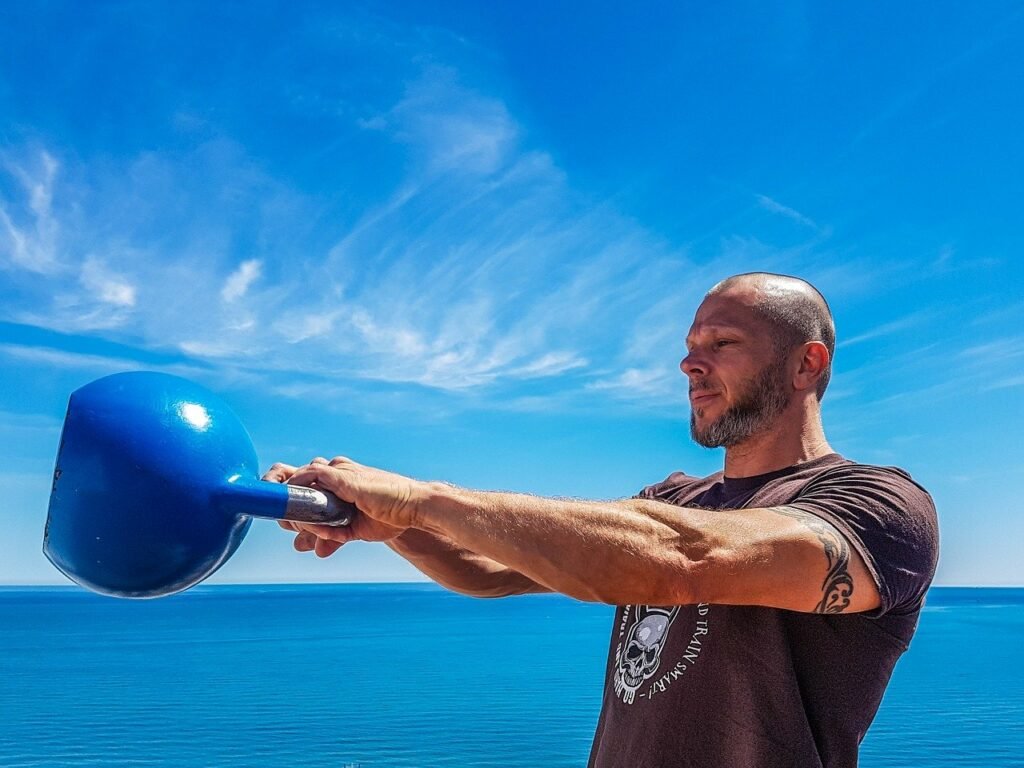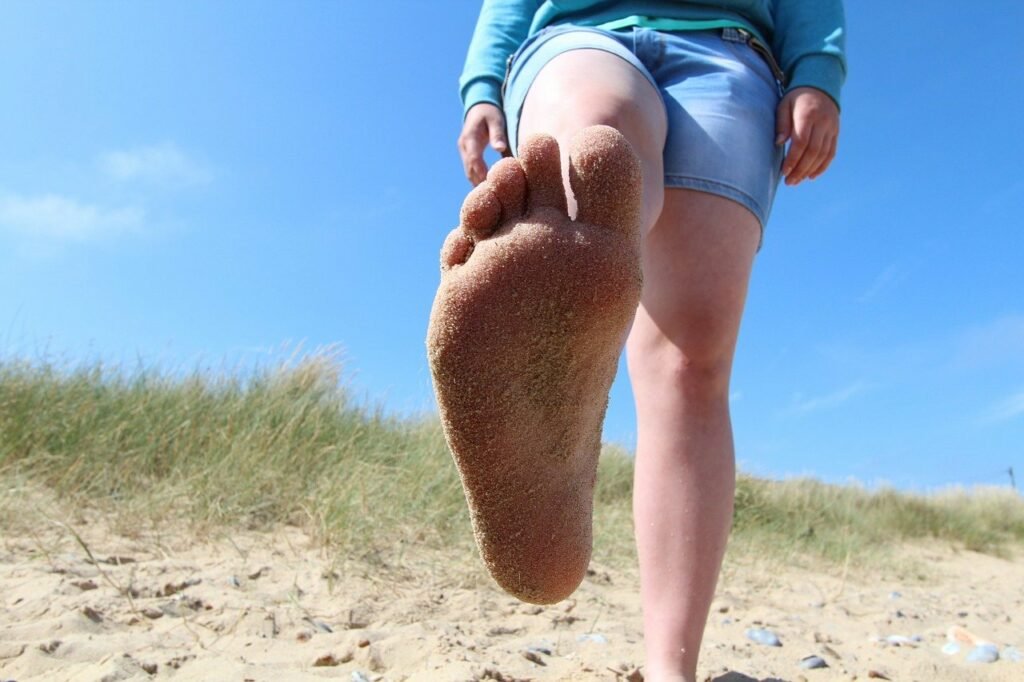Why Do Kettlebell Swings Hurt My Feet? (Here’s 4 Reasons Why)
Kettlebells have been getting more popular over recent years and have really had an impact on the fitness community.
It’s not all plain sailing for some though. Maybe you have trained with other equipment for years but for some reason kettlebells hurt your feet.
Theres are many factors to consider when using a kettlebell, they can be brutal and unforgiving if they aren’t respected.
Why do your feet hurt and what can you do to prevent this and also what can be done to help to help the pain now?
Read on to find out why and how.
Why Do Kettlebell Swings Hurt My Feet?
Kettlebells swings hurt your feet for a number of reasons, one could be that you have a case of plantar fasciitis. This is where there has been too much strain placed on the foot. The plantar fascia is the long, thin ligament that runs along the bottom of your foot. It provides arch support and connects the heel to the front of the foot. Other reasons could be down the fact you are not used to training with kettlebells, by not having your body comfortable with how they move. An over compensation of using kettlebells may mean you are putting too much strain on your lower body, maybe you have a tight achilles tendon or calf, which means the feet are having to work harder? You also have to think about how often you train, what you train, your choice of footwear, how heavy is the kettlebell and how many reps are you doing in a workout?
1. Posture And Foot Position
One of the biggest problems newbies come across, is just how different kettlebells are to train with compared to traditional equipment.
With kettlebells being used for ballistic training and offering more compound based exercises than a lot of dumbbell workouts, it’s easy to neglect the fact that there are more muscles at play here.
Which means if you aren’t used to training this way, it can feel like you have been in the boxing ring when you wake up the next morning.
Theres many muscle groups at one time that come into play with kettlebells and if you don’t have the correct posture, you can find yourself in a spot of bother.
Make sure your body is all in line when swinging. Don’t have you’re knees too wide apart and feet pointing out. Have a good centre of balance and make sure your lower body has a good line from which is natural to you and won’t put too much stress on certain parts with you having a bad posture.
Try and relax when using kettlebells, loosen the tension all over your body and drop them shoulders. Showing good composure will help you enjoy the workout. Keeping the kettlebell under control isn’t easy, but keeping it tight to your body and not letting it swing loosely will enhance your experience.
Foot positioning is very important, having them pointing out can put extra stress on the inside of your foot, while having them pointing in can do the same for the outer part of your foot…not to mention your knees too!
Have your feet pointing forward, with your knees in line above the feet, between the second and fifth toe.

2. Planter Fasciitis
Plantar fasciitis is when you have pain on the bottom of your foot, around the heel and arch. You can usually ease the pain yourself, but see a doctor if the pain does not improve within 2 weeks.
It’s more likely to be plantar fasciitis if the pain is much worse when you start walking after sleeping or resting, the pain feels better during exercise, but returns after resting or it’s difficult to raise your toes off the floor.
A doctor might refer you to a physiotherapist for exercises or to see a podiatrist (foot specialist), who can recommend certain insoles and footwear to try.
Plantar fasciitis is commonly caused by repetitive strain injury to the ligament of the sole of the foot. This can be from excessive running or walking, inadequate foot gear and maybe a jumping injury from landing badly.
RELATED – Why Do Kettlebells Feel Heavier Than Dumbbells?
3. Do You Come Here Often?
What I mean here is…how often do you train? Are you a regular gym goer or are you only training occasionally? As if you only train on the odd occasion maybe think about the mobility in your hips, knees and ankles.
As mentioned above, if you don’t have the correct posture when using kettlebells you can put massive strain on your body and if you aren’t used to training with them, they can highlight the fact you haven’t been training regularly.
It’s crucial to always warm up before you workout. This gets over looked by lots of people until an injury occurs. I have done this myself and it can be very frustrating.
Kettlebells move differently to other equipment and this can put strain on other areas that don’t normally get worked when training with dumbbells etc.
Consider doing some mobility drills on your hips, knees and ankles to help loosen them up to get used to this type of training.
What weight kettlebell are you using? This is another thing newbies fall victim to. Just because you can curl 16kg dumbbell, doesn’t mean you can smash out the same weight with kettlebell.
You could do and might be ok, but for the majority who try this will come unstuck.
A 16kg kettlebell will seriously push you hard if you aren’t used to kettlebells, don’t train that often or have bad mobility.
Consider using a lighter kettlebell when starting out…maybe 8kg or less, get used to the way they move and ease yourself in to exercising this way.
Don’t try and do too many reps when you begin training with kettlebells, its best to start off small and build up gradually, doing too many reps in one workout can put extra strain your feet and cause pain.
Do you take part in any other fitness activity? Do you run, cycle or anything else that could be partly responsible for the foot pain?
If you have been running recently and incorporated kettlebells into your program, you may need to reduce the distance you are running if this is the case.
It also helps to realise this issue is almost always caused by an overuse or overstrain…don’t sprint or push hard off your toes when you haven’t built up to it.
RELATED – ALL OF MY WORKOUTS HERE

4. Sedentary lifestyle and health
This ties in with the above point, how active is your job? Are you sat on a chair for hours on end? Having a sedentary job is one of the main causes of getting planter fasciitis. This is down to weakness of under use rather than over use with running and kettlebells etc.
Make sure you stay as active as possible if you have this type of job, easier said than done I know.
Maybe you need to think about changing your footwear? Having the wrong shoes can play a massive role in your feet hurting when doing kettlebell swings or any other activity for that matter.
There is a large variety of sport insoles to help cushion and protect your feet should you need them. There are also lots of trainer/sneaker shops that offer the service of tracking your running gate to see which trainer is best for the shape of your feet and arch.
Working out bare foot is not advised if you have foot issue, although it has helped some people. The general consensus is that you need good cushioning with your trainers for good shock absorption.
How was the condition of your feet before you started training with kettlebells? If you have problems with your feet beforehand, it might be worth seeing your doctor and getting the issue looked at before it gets worse.
The shape of your feet can have a bearing on training also. Do you a slight foot pronation? This is where your feet lean inwards when you walk. You could have foot supination, this is where your feet lean outwards when you walk.
We are all built differently, an easy way to tell if you have one of these would be to check the soles of your shoes.
If they are worn on either side of the heel, this is a tell tale sign of the condition.
If you would consider yourself overweight, then this could be a reason why you get foot pain and this too is a contributing factor to getting planter fasciitis. Having the extra weight will put stress your lower body and cause pain to your feet along with other body parts too.
Final Thoughts…
If kettlebell swings are hurting your feet, there’s a variety of reasons as to why this is.
One of the reasons above or even a combination could be the reason you get foot pain. Normally I would say it is down to not being used to the equipment and you are being too tense when swinging, but it could be down to a number of reasons.
Either way, I hope that you get to the root of the problem and you can get back to swinging your kettlebell in no time.
If you enjoyed this, then please check out the YouTube channel, with over 40 workouts which include the use of kettlebells, resistance bands, dumbbells and even body weight exercises too.
Don’t forget, I will be adding more workouts weekly to help you stay fit and healthy at home with just the use of a kettlebell.
With workouts of all types, for all fitness levels. You know that we have you covered, so stay tuned for more.
If you enjoy sport and use CBD to help with your recovery in between gruelling workouts, then your are in the right place. Here at Sport CBDs, we train hard and recover the best way possible…
We have regular workouts (check out the YouTube channel), CBD news and CBD products to help you gain that edge!
If you wanted to check out the reputable CBD we have on offer here at the site, then please head to the Sport CBDs Store. We also do fitness clothing and yoga accessories too.
Untill next time, all the best…


